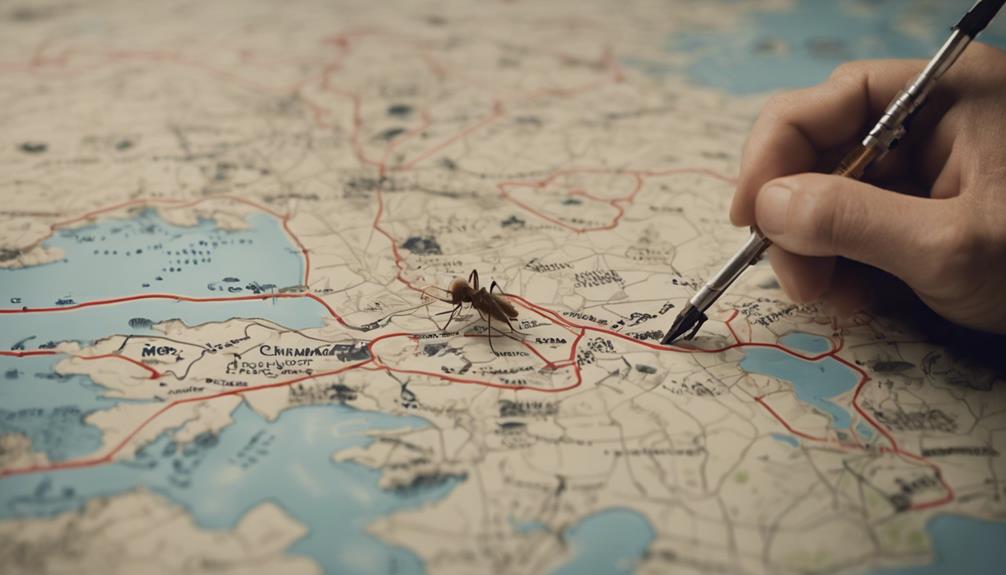Imagine you’re living in St. George, where the rising temperatures have led to a noticeable increase in spider infestations, particularly venomous species like the black widow. You’re aware that the desert’s dry climate provides a perfect breeding ground for these arachnids, and their search for cooler environments brings them directly into your home.
This situation raises significant concerns for your family’s health and safety. To grasp the full extent of this issue and explore effective solutions, it’s imperative to understand the link between climate change and spider population dynamics in the area.
What strategies could potentially mitigate these surges, ensuring the well-being of St. George’s residents?
Key Takeaways
- Warmer temperatures in St. George lead to increased spider populations and indoor infestations.
- Heavy rainfall and flooding drive more spiders into homes seeking refuge.
- Urbanization in St. George disrupts natural habitats, pushing spiders into residential areas.
- Effective pest control in St. George requires adapting to the local desert climate’s impact on spider behavior.
Rising Temperatures, Rising Spiders
As temperatures in St. George continue to rise, so does the population of spiders, creating a direct correlation between warmer climates and increased spider infestations. This trend isn’t just a mere inconvenience but a clear indicator of how climate change directly impacts local ecosystems and, by extension, our homes.
Warmer conditions create an ideal breeding ground for spiders, accelerating their metabolism and making them more active. Consequently, you’re likely to notice more spiders seeking shelter indoors, a situation that underscores the urgent need for effective pest control measures.
This shift in spider behavior and habitat, driven by rising temperatures, demands a proactive approach to pest management, ensuring that our living spaces remain safe and comfortable amidst the challenges posed by climate change.
Precipitation Patterns and Pest Populations
Understanding the impact of rising temperatures on local spider populations sets the stage for examining how increased precipitation patterns also play a significant role in altering pest behaviors and infestations in St. George.
With more rain, you’ll find more spiders seeking refuge in your home, escaping the wet conditions outside. These periods of heavy rainfall and even flooding can spike spider infestations, turning your residence into a haven for these pests.
Excessive moisture doesn’t just drive spiders indoors; it creates the perfect breeding grounds for them, exacerbating the problem. Recognizing how precipitation patterns influence spider behavior is important.
Extreme Weather and Ecosystems
Extreme weather events, including both periods of drought and heavy rainfall, greatly disrupt St. George’s ecosystems, thereby affecting local spider populations and their behaviors.
You might’ve noticed spiders creeping into your space more often during these times. It’s not just your imagination. Drought conditions push them indoors, seeking shelter and moisture, while heavy rains drive them to escape flooded habitats.
These invaders aren’t acting randomly; they’re responding to their changing environment. Temperature swings further complicate their behavior, altering their movement patterns and nesting locations.
Climate change is reshaping the web of life, affecting the availability of prey and, consequently, spider distribution and abundance. This chain reaction underscores the intricate connections within ecosystems and highlights why you’re seeing more spiders during extreme weather, leading to increased indoor infestation risks.
Human Impact and Habitat Changes
Human activities, including construction and landscaping in St. George, greatly disrupt spider habitats, leading to changes in their population and behavior. Urbanization and deforestation, as forms of land use change, markedly affect spider communities. These habitat alterations create new environments that some spider species exploit, resulting in increased infestations in urban areas.
Additionally, climate change plays a vital role by influencing spider distribution patterns and behavior in St. George. This phenomenon, combined with human-induced habitat changes, contributes to the proliferation of certain spider species within urban settings. You’re witnessing an interplay between human impact and natural systems, where actions such as urban development and climate change synergistically drive alterations in spider populations, reshaping the ecological balance in St. George.
Mitigating Spider Surges
To effectively mitigate spider surges in St. George, it’s essential to employ a combination of targeted pest control measures and strategies attuned to the local climate’s influence on spider populations. Understanding the desert climate’s role in fostering spider infestations allows Pest Control in St. George to develop precise interventions.
By adapting to temperature fluctuations and the dry conditions that favor these pests, you can proactively reduce the risk of widespread infestations. Implementing consistent monitoring and timely pest control responses, tailored to the unique desert environment, guarantees that spider populations are managed effectively.
This scientific, detail-oriented approach, grounded in a deep understanding of the local climate’s impact on spider behavior, fosters a sense of belonging among community members united in the fight against spider surges.
Frequently Asked Questions
Are There Tarantulas in St George Utah?
You’re unlikely to find tarantulas in St. George, Utah, due to its unsuitable climate for their desert adaptations, reproductive cycles, and tarantula habitats. Their seasonal appearances elsewhere don’t match the local environment, making sightings rare.
What Bugs Are in St George Utah?
In St. George, you’ll encounter ants, beetles, and a burgeoning mosquito population. Ant control methods, beetle diversity, and pest management strategies are essential. Understanding these bugs’ behaviors fosters a sense of community and proactive preparedness.
What Spiders Do for the Environment?
Spiders are essential for the environment, offering pest control, supporting biodiversity, and maintaining ecosystem balance. They assist in pollination and play a key role in food webs, contributing greatly to ecological stability and health.




